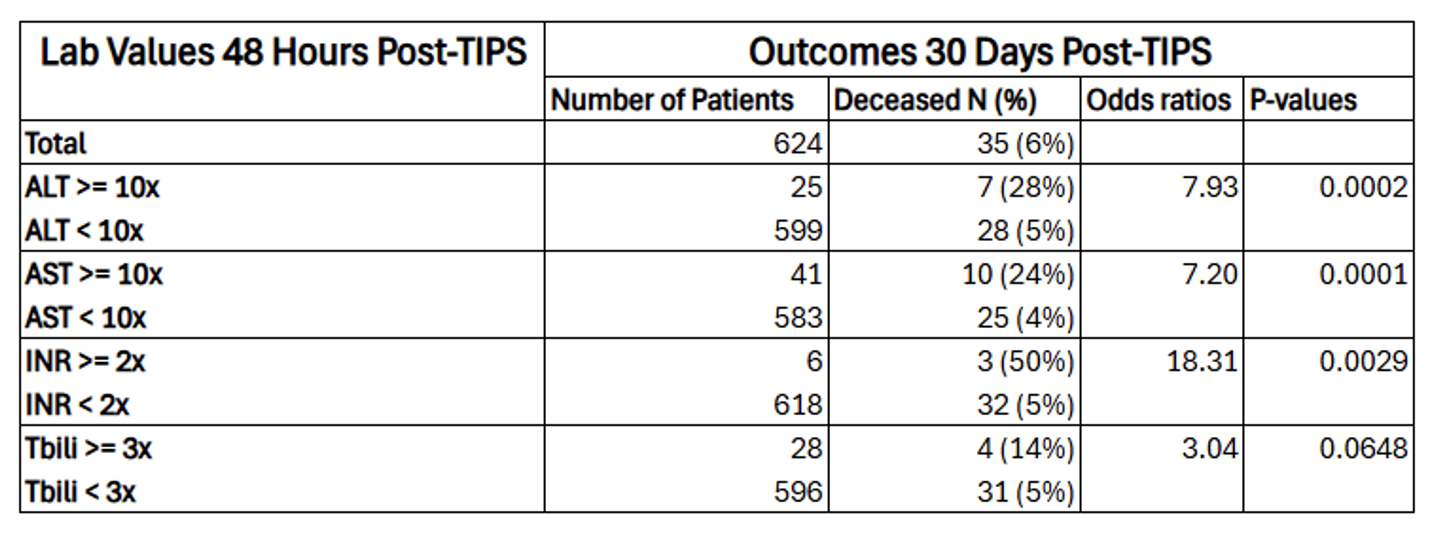Monday Poster Session
Category: Liver
P3642 - Hyper Acute Liver Injury After Transjugular Intrahepatic Portosystemic Shunt Placement
Monday, October 27, 2025
10:30 AM - 4:00 PM PDT
Location: Exhibit Hall
- AT
Anna Thiemann, MD
California Pacific Medical Center
San Francisco, CA
Presenting Author(s)
Anna Thiemann, MD, R. Todd Frederick, MD
California Pacific Medical Center, San Francisco, CA
Introduction: Transjugular intrahepatic portosystemic shunt (TIPS) is a well-established intervention for portal hypertension and its complications. While hepatic encephalopathy is a common post-TIPS complication, hyperacute liver injury or acute on chronic liver failure (ACLF) immediately following the procedure is rare and poorly understood. We aimed to characterize the incidence and features of hyperacute liver injury occurring within 48 hours of TIPS placement and association with mortality within 30 days.
Methods: We conducted a retrospective review of all patients who underwent TIPS at a single tertiary care center between March 2015 and January 2024. Hyperacute liver injury was defined as lab abnormalities of ≥2-fold increase in INR, ≥3-fold increase in total bilirubin, and ≥10-fold increase in AST and/or ALT compared to baseline, occurring within 48 hours post-TIPS. Demographic, clinical, and procedural data were collected and analyzed. Odds ratios with corresponding p-values were calculated using Fisher’s exact test to assess associations between lab abnormalities and clinical outcomes.
Results: A total of 624 patients underwent TIPS during the study period. Thirty-day mortality was 6% (35 patients). Significant elevations in liver enzymes 48 hours post-TIPS were associated with markedly increased mortality. Among patients with ALT ≥10 fold increase, 28% died within 30 days compared to 5% with ALT < 10 fold increase (OR 7.93, p = 0.0002). Similarly, AST ≥10 fold increase was associated with a 24% mortality rate versus 4% in those with lower AST (OR 7.20, p = 0.0001). Patients with INR ≥2 fold increase at 48 hours had a 50% mortality rate compared to 5% with INR < 2 fold (OR 18.31, p = 0.0029). Elevation in total bilirubin ≥3 fold was associated with a trend toward increased mortality (14% vs. 5%, OR 3.04, p = 0.0648), though this did not reach statistical significance. These findings suggest that early, marked hepatic injury post-TIPS strongly correlates with 30-day mortality.
Discussion: Severe hepatic injury within 48 hours of TIPS placement is strongly associated with increased 30-day mortality. Marked elevations in transaminases, INR, and bilirubin may serve as early warning signs of impending ACLF and multi-organ dysfunction. These findings are clinically useful, enabling providers to identify high-risk patients shortly after TIPS. Further research is needed to better define the risk factors and mechanisms underlying this rare but serious complication.

Figure: Lab Abnormalities Associated with 30 Day Mortality
Disclosures:
Anna Thiemann indicated no relevant financial relationships.
R. Todd Frederick: Astra Zeneca – Grant/Research Support. Mallinckrodt – Consultant, Grant/Research Support. River2Renal – Grant/Research Support. Salix – Grant/Research Support.
Anna Thiemann, MD, R. Todd Frederick, MD. P3642 - Hyper Acute Liver Injury After Transjugular Intrahepatic Portosystemic Shunt Placement, ACG 2025 Annual Scientific Meeting Abstracts. Phoenix, AZ: American College of Gastroenterology.
California Pacific Medical Center, San Francisco, CA
Introduction: Transjugular intrahepatic portosystemic shunt (TIPS) is a well-established intervention for portal hypertension and its complications. While hepatic encephalopathy is a common post-TIPS complication, hyperacute liver injury or acute on chronic liver failure (ACLF) immediately following the procedure is rare and poorly understood. We aimed to characterize the incidence and features of hyperacute liver injury occurring within 48 hours of TIPS placement and association with mortality within 30 days.
Methods: We conducted a retrospective review of all patients who underwent TIPS at a single tertiary care center between March 2015 and January 2024. Hyperacute liver injury was defined as lab abnormalities of ≥2-fold increase in INR, ≥3-fold increase in total bilirubin, and ≥10-fold increase in AST and/or ALT compared to baseline, occurring within 48 hours post-TIPS. Demographic, clinical, and procedural data were collected and analyzed. Odds ratios with corresponding p-values were calculated using Fisher’s exact test to assess associations between lab abnormalities and clinical outcomes.
Results: A total of 624 patients underwent TIPS during the study period. Thirty-day mortality was 6% (35 patients). Significant elevations in liver enzymes 48 hours post-TIPS were associated with markedly increased mortality. Among patients with ALT ≥10 fold increase, 28% died within 30 days compared to 5% with ALT < 10 fold increase (OR 7.93, p = 0.0002). Similarly, AST ≥10 fold increase was associated with a 24% mortality rate versus 4% in those with lower AST (OR 7.20, p = 0.0001). Patients with INR ≥2 fold increase at 48 hours had a 50% mortality rate compared to 5% with INR < 2 fold (OR 18.31, p = 0.0029). Elevation in total bilirubin ≥3 fold was associated with a trend toward increased mortality (14% vs. 5%, OR 3.04, p = 0.0648), though this did not reach statistical significance. These findings suggest that early, marked hepatic injury post-TIPS strongly correlates with 30-day mortality.
Discussion: Severe hepatic injury within 48 hours of TIPS placement is strongly associated with increased 30-day mortality. Marked elevations in transaminases, INR, and bilirubin may serve as early warning signs of impending ACLF and multi-organ dysfunction. These findings are clinically useful, enabling providers to identify high-risk patients shortly after TIPS. Further research is needed to better define the risk factors and mechanisms underlying this rare but serious complication.

Figure: Lab Abnormalities Associated with 30 Day Mortality
Disclosures:
Anna Thiemann indicated no relevant financial relationships.
R. Todd Frederick: Astra Zeneca – Grant/Research Support. Mallinckrodt – Consultant, Grant/Research Support. River2Renal – Grant/Research Support. Salix – Grant/Research Support.
Anna Thiemann, MD, R. Todd Frederick, MD. P3642 - Hyper Acute Liver Injury After Transjugular Intrahepatic Portosystemic Shunt Placement, ACG 2025 Annual Scientific Meeting Abstracts. Phoenix, AZ: American College of Gastroenterology.
